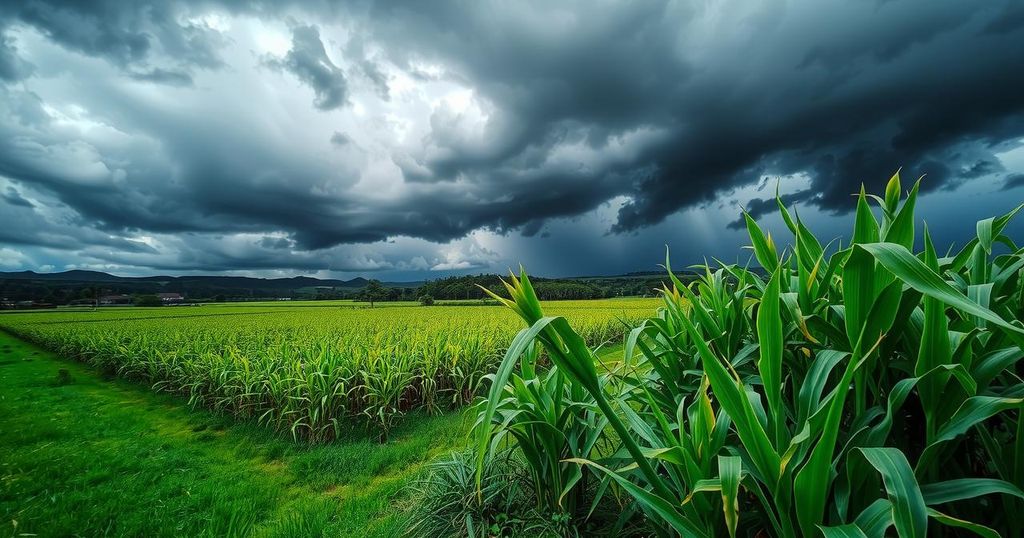Weather
ASIA, BIO - ENERGY MANUFACTURES ASSOCIATION, BRAZIL, DATAGR, EUROPE, GREEN POOL COMMODITY, GREEN POOL COMMODITY SPECIALISTS, INDIA, INDIAN SUGAR AND, INDIAN SUGAR AND BIO - ENERGY MANUFACTURES ASSOCIATION, INTERNATIONAL SUGAR ORGANIZATION, ISO, LONDON, MARKET ANALYSIS, MARKET TRENDS, MARKETS, NY, RAIN, SOMAR METEOROLOGIA, SOUTH AMERICA, STOCK MARKET, SUCRES ET DENREES SA, UNICA, UNITED KINGDOM, WILMAR INTERNATIONAL LTD
Daniel O'Connor
0 Comments
Sugar Prices Decline Amid Rain Forecasts and Production Concerns
Sugar prices have dropped due to rain forecasts in Brazil, which will likely improve sugarcane yields. Notably, forecasts have highlighted declining production globally, particularly in Brazil and India, contributing to market tension amidst weak demand. Overall, while rain may boost supply, global production estimates remain concerning, painting a complex picture for the sugar market.
Sugar prices have witnessed a decline following forecasts of rain in Brazil, which is expected to alleviate dryness concerns and potentially increase sugarcane yields. Specifically, May NY world sugar 11 decreased by 0.18 to 0.94%, while May London ICE white sugar 5 fell by 1.40 to 0.26%. The forecast by Somar Meteorologia indicates widespread rainfall in Brazil next week.
Despite an initial surge in sugar prices this week due to signs of decreased global sugar production, the market recently shifted downwards. Notably, Unica reported a 5.6% year-on-year decline in cumulative sugar output for the Center-South region of Brazil for the 2024/25 crop year, totaling 39.822 million metric tons (MMT). Concurrently, the Indian Sugar and Bio-energy Manufacturers Association reduced its sugar production forecast for India from 27.27 MMT to 26.4 MMT, attributing it to lower cane yields.
The International Sugar Organization (ISO) has also revised its 2024/25 global sugar deficit forecast from -2.51 MMT to -4.88 MMT, indicating a tightening in the market. Furthermore, the ISO revised its production estimate down to 175.5 MMT from 179.1 MMT. Green Pool Commodity Specialists projected a return to surplus, expecting a 2025/26 crop year surplus of 2.7 MMT, contrary to the deficit of 3.7 MMT anticipated for 2024/25.
In related developments, sugar prices fell to seven-week lows, prompted by weak demand signals. Notably, sugar traders Wilmar International Ltd and Sucres et Denrees SA reported record deliveries of raw sugar totaling 1.7 MMT against a March NY futures contract. Large deliveries serve as bearish indicators in the market, signifying that sellers face limited alternative markets.
Further contributing to the bearish sentiment were projections from Datagro, which estimates Brazil’s sugar production for the 2025/26 season to rise by 6% to 42.4 MMT, and Czarnikow’s forecast of a record 43.6 MMT for the same period. Additionally, on January 20, the Indian government permitted sugar mills to export 1 MMT of sugar amid prior restrictions to maintain domestic supply.
The Indian Sugar Mills Association anticipates a significant decrease in sugar production for 2024/25, projecting a 17.5% year-on-year decline to 26.4 MMT, marking a five-year low. Meanwhile, Thailand’s projected sugar production increase to 10.35 MMT for 2024/25 presents further bearish prospects for sugar prices, following an 18% increase year-on-year.
Recent drought and excessive heat last year led to fires in Brazil, damaging substantial portions of the sugar crops in its primary producing state, Sao Paulo. It is estimated that up to 5 MMT of sugarcane was lost due to these conditions. Conab adjusted Brazil’s sugar production estimate downward to 44 MMT, citing lower yields from these adverse conditions.
The USDA’s bi-annual report estimated a 1.5% increase in global sugar production for 2024/25, rising to a record of 186.619 MMT, while global human sugar consumption is anticipated to grow by 1.2% to 179.63 MMT. Furthermore, global ending stocks are forecasted to decline by 6.1% year-on-year, reaching 45.427 MMT.
In conclusion, sugar prices are influenced by various factors, including weather conditions in Brazil, production forecasts, and global market demand. The anticipated rain in Brazil is likely to bolster sugarcane yields, leading to potential increases in sugar supply. Conversely, various forecasts indicate a tightening market due to declining production estimates in India and Brazil, alongside weak demand signals. Such dynamics highlight the complex interplay between supply and demand forces in the global sugar market.
Original Source: www.tradingview.com




Post Comment